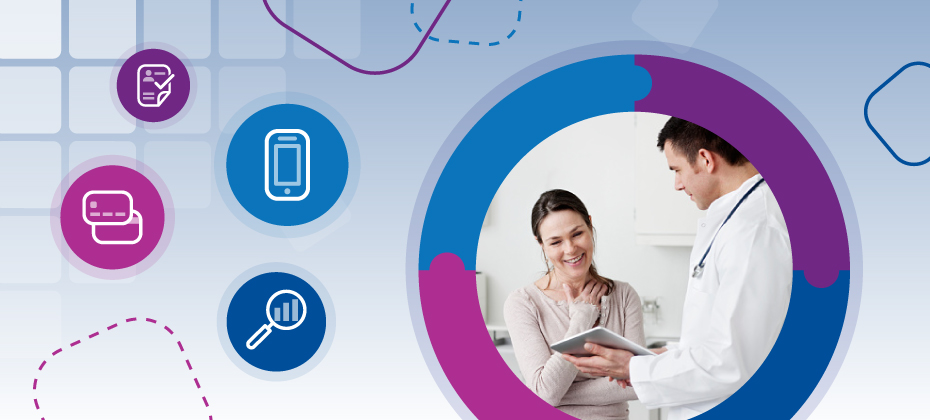Patient Experience
Learn how your organization can drive patient loyalty and create excellent patient experiences, every time.

This is the second in a series of blog posts that will highlight how the patient journey has evolved since the onset of COVID-19. This series will take you through the changes that impacted every step of the patient journey and provide strategic recommendations to move forward. In this post, we explore how 24/7 self-scheduling can help healthcare providers adapt to the post-pandemic digital landscape. To read the full white paper, download it here. If there’s one digital tool that punches above its weight in the healthcare industry, it’s online self-scheduling. This simple concept – allowing patients to book their own appointments online – resolves many sticky issues throughout the entire patient journey. It drives patient satisfaction, acquisition, and retention. It boosts staff efficiency and smooths out bumps in the revenue cycle. No-shows and delayed care can be minimized, leading to reduced costs and far better health outcomes. All of that was true before the pandemic. However, when COVID-19 hit, self-scheduling was a gamechanger. When more patients wanted to manage their healthcare online, and staff were forced to work remotely, online medical scheduling was convenient and safe. Now, the return on investment is even higher. As patients struggle to overcome growing barriers to care, and providers wrangle with soaring volumes of returning patients, the digital front door must remain open. How can providers leverage the benefits of 24/7 digital self-scheduling seen over the last year or so, and create a digital patient experience that’s fit for the future? Consumers schedule appointments differently now – and they don’t want to go back Healthcare has been playing digital catch-up to other industries for much of the last decade. Consumers have long grumbled about archaic registration processes and the absence of digital tools seen frequently in other sectors. The urgent reconfiguration of the healthcare consumer experience over the last year means many of those missing digital options are now available. Instead of calling to make an appointment during office hours, patients can use 24/7 online scheduling platforms – accessible any time, from any device. Having had a taste of convenience and control, consumers expect online scheduling to continue beyond the pandemic. According to a new Experian Health study, nearly three-quarters of consumers want to continue to schedule their own appointments online. More than eight in 10 prefer an online or mobile-related registration experience. Rather than wait in a long customer service queue, patients can make, cancel, or reschedule appointments with the push of a button. Patients of all ages like having a flexible and frictionless way to manage their care, so why would they choose a provider that doesn’t offer online self-scheduling as part of the mix? 24/7 self-scheduling reduces barriers to care In addition to meeting consumer expectations, 24/7 self-scheduling also helps providers overcome many new and existing consumer challenges in the wake of the pandemic. Patients can be blocked from accessing the care they need for all sorts of reasons – financial worries, lack of transportation, lack of time to phone and book appointments, and/or cultural barriers to seeking support. As with many public health challenges, those who experience the greatest social and economic challenges have also been hardest hit by the pandemic. While many of these issues aren’t easily resolved by any one organization, self-scheduling does offer a route around several barriers to care. By simply offering a more flexible way to book and cancel appointments and interact with their provider, self-scheduling platforms allow patients to make plans in a way that fits their circumstances. Inconvenient business hours and long waits for available appointments become less of a concern. And with automated patient outreach, providers can make the process even easier, by sending text or email reminders to specific groups of patients to make sure they get the care they need. Digital self-scheduling eases call center bottlenecks Giving patients the ability to book their own appointments online also eases the burden on call center staff. Setting up staff to work remotely, while managing an influx of patients scrambling to book COVID-19 tests and vaccinations, created many pain points throughout the pandemic. First come, first serve scheduling options create bottlenecks in call volume, and when patients can’t get through to cancel appointments they can no longer attend, those slots sit unused - wasting physician time. As patients look to reschedule deferred care, 24/7 self-scheduling can minimize these bottlenecks by relieving pressure on call center staff and spread the load across multiple channels. Call center agents can reallocate their time to higher-priority inquiries. Call times can be cut because agents will have integrated access to disparate electronic health records and project management systems. Training time can also be reduced through simplified online systems. It’s no wonder that 71% of providers offer (or plan to offer) online self-scheduling options. Building a self-scheduling ecosystem that’s fit for the future Digital self-scheduling systems implemented during the pandemic should become a permanent feature in patient access. Providers that want to create an attractive patient experience should expand their digital self-scheduling offering beyond simply booking appointments. Multiple specialty services can be integrated into the scheduling system to streamline referrals. Telehealth services that gained so much ground over the last 18 months can be connected to online scheduling tools so they’re fully embedded going forward. Digital payment options and coverage functions can also be linked to scheduling platforms, for a seamless end-to-end digital patient experience. Find out how Experian Health’s 24/7 online patient scheduling software can help your organization deliver an optimal patient experience, improve call center productivity, and reduce revenue loss as the healthcare industry adapts to the new digital landscape. Download our white paper to get patient-provider perspectives on self-scheduling and other digital trends.

In November 2020, Experian Health conducted a survey to capture consumer and provider attitudes regarding patient access. At the height of the pandemic, patients welcomed telehealth services and maintained their distance from hospital waiting rooms. Providers scrambled to implement and provide digital services that would help them maintain quality care for their patients. In June 2021, we revisited these questions to see if healthcare providers and patients changed their views on the state of patient access: The pandemic has forced rethinking how to “do” healthcare in the digital age. Patients want flexible, convenient, and contactless care; providers need to continue providing these services. Download the white paper for the full survey results and get strategies to plan for the future of healthcare.

This is the first in a series of blog posts exploring how the patient journey has transformed as a result of COVID-19. This series will take you through the changes that impacted every step of the patient journey and provide strategic recommendations to move forward. In this post, we explore the role of healthcare marketing in acquiring and re-engaging patients as they return for care. Read the full white paper here. The healthcare industry’s overnight switch to digital-first operations put marketers and patient engagement teams at the heart of the new patient-provider relationship. From helping patients navigate online services and contactless care to providing timely information about COVID-19, proactive communications became a matter of life and death. Now, the challenge has shifted again. With a growing number of patients moving locations, changing jobs, and switching health plans, healthcare providers must strengthen their marketing outreach efforts to welcome new consumers and reconnect with existing ones. Finding new strategies to communicate effectively and pointing consumers to the right services at the right time will be key to financial recovery post-pandemic. Here, we look at four opportunities that healthcare marketers and patient outreach teams can incorporate into their post-pandemic playbook. Opportunity 1: Get your records straight before investing in new healthcare marketing strategies As patients’ circumstances changed, many found their health records were out of date. Addresses were incorrect. Insurance records were incomplete. Some individuals accidentally set up duplicate accounts when registering for online services. For providers, this amplified a challenge that existed long before the pandemic – finding ways to ensure accurate patient identities. A recent survey by Experian Health found that patients welcome proactive outreach by providers, though many say their providers fail to do this. Nearly half of providers say they want to, but inaccurate or incomplete patient data gets in the way. Investing in marketing and outreach strategies is money down the drain unless providers can verify that the information they have for each patient is reliable. An identity management tool such as can confirm names, addresses and other demographic details of existing patients and those who have recently moved to the area – to correctly match their information at every digital and in-person touchpoint. Opportunity 2: Build personalized patient outreach strategies based on consumer insights Next, providers can enrich patient identities with originally sourced consumer data for a comprehensive picture of who their patients are. When providers can confirm who their patients are, what they need, how they spend their time and money, and how they like to communicate, they can build personalized outreach strategies to improve patient acquisition and retention. For example, providers have new opportunities to offer telehealth access for patients in their preferred language. Experian offers 196 language codes that can be applied based on individual patient profiles, so you can connect patients to the right physician. For patients who are new to the area, communication that reflects their lifestyles, preferred channels, and personal interests will help maintain loyalty and provide better customer experiences. The aftermath of the shift to online and digital healthcare tools has been polarizing, with some patients feeling hesitant to engage with unfamiliar tools. Others expect a more sophisticated digital experience that matches their interactions in retail and entertainment. Knowing which camp patients identify with will help your patient outreach team discern which tools and guidance to offer to which patients. With ConsumerView, you can differentiate your services from other health systems vying for the same consumers, and offer a tailored engagement experience. Opportunity 3: Reduce readmission risk with data on social determinants of health Knowing whether your new and existing patients are affected by social determinants of health (SDOH) can also help tailor outreach communications. This can help them overcome access challenges and reduce the risk of readmission. Understanding if patients are at risk of missing appointments or struggling to follow a care plan because of food insecurity, isolation, lack of transportation, cultural exclusion, or financial limitations, can help providers point them to relevant community programs and financial support. By understanding patient barriers, providers will be able to communicate more effectively with their patients. For example, a conversation with someone who is experiencing unexpected, short-term financial difficulties as a result of losing their job in the pandemic would be much different than a conversation with someone who has been unemployed and low-income for many years. Opportunity 4: Reschedule deferred care by marketing online scheduling platforms Seven in ten patients deferred or canceled treatment during the pandemic. Providers must figure out where those patients are and what their (potentially more serious) healthcare needs may be. Re-engaging and rebuilding relationships with these patients is critical to encourage them to come back for care. Marketing teams play a major role in raising the visibility of non-coronavirus health issues and the need to reschedule care and return to a pre-pandemic healthcare routine. Third-party data can fill in the gaps in patient identities, so providers can identify specific needs and worries, determine the best contact information for each patient, and re-engage effectively. Online scheduling platforms will be especially important. These platforms can help patients reschedule appointments at their convenience, connect them to telehealth services, and overcome some of the practical barriers to care. Find out how Experian Health can help your organization access new sources of data and see how your patient community has changed since March 2020, down to the individual level. By combining identity management software with accurate consumer insights, your marketing and outreach teams will be armed with everything they need to attract and retain satisfied consumers. Download our white paper to see how other steps of the patient journey have evolved since the onset of COVID-19.

COVID-19 changed every aspect of the patient journey – placing unprecedented demands on the healthcare system and accelerating the need for digital transformation industry-wide. Telehealth, touchless engagement, and self-service scheduling became the new normal; however, this created new stress on operations, administration, and finance. While this new normal comes with many challenges, data and digital tools have created greater accessibility, engagement, transparency, and control for patients and providers. In this blog, we examine COVID-19’s impact on the patient journey and explore the digital tools and data that are helping the healthcare industry recover and thrive. To get more insights, read the full whitepaper here. COVID-19 strained the healthcare system more than ever before. To say that COVID-19 challenged the healthcare system is a massive understatement. Seven in 10 patients deferred or canceled treatments during the pandemic, causing disruptions to both revenue and patient engagement. Even behind the scenes, novel diagnostic codes and new sources of information—together with rising inpatient volume and government intervention—affected costs, billing and reimbursements at scale. Patient-provider relationships became much more complex. Many people moved, changed jobs and changed insurance during the pandemic. In fact, an estimated 40 million Americans lost work during the pandemic and just over half of all workers in North America plan to look for new work in 2021. As a result, relationships between physicians and patients became disrupted. While re-engagement is critical for providing care, simply finding patients remains a challenge. The digital experience raised patient expectations. As consumers turned to technology to cope with changes, digital engagement increased in healthcare services and elevated consumer expectations. This trend began before the pandemic: A pre-COVID-19 AARP survey of older adults (50+) found that a majority would prefer to have their healthcare needs managed by a mix of medical professionals and technology. During the pandemic, patients used telehealth to access care from home, mobile registrations to avoid filling out paperwork in the waiting room and digital payment options that made paying bills simple and seamless. Now that patients have experienced telemedicine, self-service scheduling and easy digital payments, there is no going back. Expectations have changed permanently, and providers that don’t offer an updated patient experience may suffer by comparison. Opportunities for better outcomes: transforming the patient journey with digital transformation We looked at key parts of the patient journey where technology is helping healthcare providers engage and care for their patients successfully across the marketing, scheduling, registration, authorization, treatment, claims and payment. Here are a few strategic opportunities for providers to consider post-COVID: 1. Use smart data for better outcomes Third-party data is helping providers find and re-engage patients, deliver more holistic care and facilitate better financial outcomes. For example, integrating data on social determinants of health (SDOH), can provide physicians with a more holistic picture of non-medical factors that may influence medical outcomes, such as a patient’s socioeconomic status. SDOH data can also shine a light on a patient’s ability to pay, which in turn may inspire a wider range of payment options so that more patients can afford care, and more providers can avoid write-offs. 2. Continue using technology and automation for the recovery to come Using digital self-service applications for registration does more than just provide the patient-friendly option of completing paperwork at home (instead of the waiting room). It also eliminates the need for staff hours spent inputting information, reduces the potential for error, and improves efficiency. Advances in automation make it possible for providers to reduce the effort of manual tasks - like sorting through patient records from disparate sources to create a single, comprehensive patient file, or gathering the information necessary to revisit claims authorization for deferred care. Across the board, digitalization provides greater transparency, flexibility, and seamless experiences for patients and providers alike. 3. Clear the path for payments Going digital can help patients and providers better navigate the patient journey, especially when it comes to payments. As many as half of nonretired adults expect long-term financial effects as a result of the pandemic. This makes it more imperative than ever to improve and accelerate authorization, claims, and payment processes so that both patients and providers have a clearer understanding of how care will be paid for. Accurate patient estimates, coverage discovery, automated authorizations, and payments all play a role in creating a better financial experience going forward. Digital transformation gains traction as we look to the future Although the digital transformation was already underway before COVID-19, the pandemic has accelerated the need for data, automation, and self-service tools. Find out how Experian Health can help your organization meet the data challenges of the post-COVID-19 patient journey by downloading our white paper.

"93% of providers say creating a better patient experience remains a top priority, up 3% from last year." - Experian Health's State of Patient Access, June 2021 In November 2020, we surveyed patients and providers for their sentiments on how patient access changed because of the pandemic. During this time, patients welcomed the convenience and control that came with digital, contactless care. Providers knew they needed to improve their digital front door to withstand the financial impact of COVID-19, but implementation was difficult for many organizations. Six months on, and millions of immunized Americans later, the pandemic landscape shifted again. In June 2021, we revisited these questions to find out if patient and provider views have changed - in our State of Patient Access 2.0. Now, patients tell us they feel more confident about returning to facilities, though they still want the flexibility and convenience of digital scheduling, registration, and payment options. Providers feel a growing urgency to make sure online services are sufficiently agile enough to withstand any future surges in COVID-19 case numbers. The findings of the survey reveal four major opportunities to rethink how we “do” healthcare. By innovating and building on the digital advances made possible during the pandemic, providers can create better patient access experiences for the future. To start, providers should: 1. Match consumer expectations for convenient and flexible patient access Our recent survey shows that the pandemic has cemented consumer expectations around convenient access to care. Digital and remote channels for scheduling appointments, completing pre-registration, and making payments have become the new baseline in patient access. Nearly three quarters of patients told us they want to schedule their own appointments online. Providers know this: 93% say creating a better patient experience remains a top priority, up 3% from last year. Online self-scheduling can help providers continue to meet their patients’ demands for flexibility and convenient access to care. Patients can find, book and cancel appointments whenever and wherever they prefer. It’s also a win for providers, who can expect to see a drop in administration errors, no-shows, and denied claims. 2. Streamline prior authorizations as more patients return to care Interestingly, new data reveals that patients are less anxious about in-person care. In 2020, 40% of patients were uncomfortable coming into waiting rooms and seeing their doctor in person. Now, only 16% say they wouldn’t be comfortable in a waiting room. As more patients rush to reschedule deferred care, providers are faced with the challenging combination of higher patient volumes, patients jumping health plans as a result of job losses, and changing payer rules around prior authorizations and coverage checks. Automated pre-authorization and automated coverage checks can relieve the pressure, and help providers save time and resources. 3. Promote price transparency for fewer missed payments An encouraging piece of insight from our latest survey reveals that far fewer patients say they’ve been surprised by their final medical bill. In 2020, more than 50% received a final figure that differed significantly from estimates. Six months later, that figure has dropped to just 14%. Price transparency remains important, and the gap between estimated and final costs seems to be closing. More providers are offering patient billing estimates, with 9 in 10 agreeing that accurate estimates increase the chance of bills being paid on time. Many are also giving patients more options to pay bills earlier in the journey, which has helped to minimize the risk of late and missed payments. Easy and accessible digital options are featured heavily in acquisition and retention plans, and can help drive financial recovery. 4. Tighten up data strategies with better security, quality and insights While our first survey revealed that the sudden shift to digital-first patient access was a shock to the system for many providers, the second study shows that both patients and providers are settling into digital ways of working. But as these digital services become the new baseline, providers must make sure their data strategies are fit for purpose, and prioritize data security, quality and insights. Moving forward, a multi-layered approach will help providers authenticate and secure patient identities. When these identities are enriched with information about how patients are affected by the social determinants of health, providers will be better positioned to offer personalized patient access experiences and support marginalized groups. The future of healthcare is digital. Is your organization prepared? It’s clear from our recent survey that the digital trends that emerged in 2020 are set to continue throughout 2021 and beyond. Download the State of Patient Access 2.0 white paper to get the full survey results and explore how data and digitalization can power a 24/7 patient access experience in your healthcare organization.

As the country strives to ramp up the pace of COVID-19 vaccinations, providers need to take new approaches to drive registration volume. Healthcare experts are increasingly concerned about the rapid spread of the highly contagious delta variant, which now makes up over 83% of COVID-19 cases. This variant is estimated to be 60% more transmissible than previous strains, and while vaccination doesn’t eliminate the risk, it does reduce the likely severity of infection, which is better for both individuals and health services. Ramping up the vaccination program and ensuring that a large proportion of the population receives the injection just became a lot more urgent. This is also critical for vaccine management plans as the U.S. looks to offer and roll-out booster shoots later this year. The initial vaccine rollout was plagued with issues, many of which remain unresolved. An uneven rollout, confusion over where to get vaccines, and logistical obstacles with preparation, distribution and funding at the state level meant the program got off to a slow start. Consumers were deterred from registering due to inefficient scheduling systems, while others were left frustrated by basic user interface challenges. And for those less familiar with digital technology, the shift to online platforms took some getting used to. Now, with the delta variant taking hold, and vaccine hesitancy on the rise, healthcare providers need to consider how digital technology can make vaccinations more accessible, rather than becoming the obstacle. Improving the user experience through digital tools and automation can reduce barriers to care, drive up vaccine registrations, and ultimately lead to better outcomes for individual and population health. Poor UX creates avoidable barriers to scheduling care One of the major accessibility challenges for consumers was being able to schedule vaccine appointments. In the initial rush to get vaccinated, demand outstripped supply, and online scheduling systems struggled to bear the load. Some providers tried to rely on email booking systems or third-party event schedulers – which resulted in communication errors, delays, missed appointments, and huge burdens on call center staff. For individuals who were unable to use online systems due to limited internet access, disability, or unfamiliarity with the technology (for example, as reported by some older people), the inaccessible and non-intuitive user interfaces created a digital divide. The poor user experience also contributed to some individuals feeling hesitant about seeking the vaccine, eroding their trust in the system as a whole. Efforts to increase and ramp up vaccination rates will be much more successful if the scheduling process is simplified. Frictionless scheduling and registration can drive up vaccine rates With the right data and digital tools, many of these patient access challenges can be resolved. Frictionless self-scheduling and streamlined registration processes can make it easier for people to book appointments and register for the vaccine. For example: Online scheduling platforms allow patients to book and reschedule vaccine appointments whenever and wherever it’s most convenient, as part of a multichannel approach. Automation enables providers to create an outreach list of patients who may be waiting for the vaccine, and send automated reminders by text or email. These can be used to disseminate accurate information to alleviate vaccine hesitancy. The messages can also be personalized to follow the patient’s individual communication preferences. Consumer data and analytics on the social determinants of health can be folded into communications, to tailor information to specific segments of the population who may have been adversely affected by barriers to care. Scheduling software can pull together real-time booking and registration data into a single, holistic view of patient access, whether patients booked via online platforms, call centers or in provider offices. This will help alleviate bottlenecks and make better use of staff resources. Digital tools can improve the patient experience and supercharge vaccine management plans, but only if they are implemented properly. Experian Health’s Director of Product Management, Liz Serie, says, “The old way of doing patient intake involves piles of paper, clipboards and long waits in the waiting room. The new way involves automation, pushing relevant and personalized information to patient’s devices, and seamless data management to initiate the patient journey. It’s a reassuring, simple and reliable user experience, especially as many still need to be vaccinated. And as patient volumes drive back up, investing in a welcoming digital front door is critical.” The future of patient access is digital, and providers that get their systems up and running effectively now will reap the benefits in the long run. Find out more about how data and digital tools can make vaccine appointment scheduling a breeze for your patients and patient access team.

Consumer-led care hit its stride during the pandemic. COVID-19 unlocked healthcare’s digital front door, giving patients more control over how and when they schedule and manage appointments. Unfortunately, while digital patient access has made navigating the healthcare system more convenient and flexible in many ways, consumers are discovering that one of the more frustrating aspects of the healthcare experience has failed to keep pace with scheduling, payments and other digital advances: registration. Waiting rooms. Paperwork. Misplaced insurance cards. Confusing copays. More paperwork! A hassle before the pandemic, registration has become even more challenging for staff and patients in the context of “contactless care.” With more patients starting to come back through the door as a result of vaccination programs and rescheduled elective procedures, there’s an opportunity for providers to smooth out the kinks in the registration experience. Vaccine “hesitancy” has exposed wider issues in patient registration Headlines suggest that large numbers of patients are fearful of being vaccinated against COVID-19. But dig a little deeper, and the issue is more complex. Many patients do want to be vaccinated, but struggle to navigate complicated registration websites, and therefore aren’t showing up for their shot. The Kaiser Family Foundation reported in January that two thirds of patients were unsure of how to access the vaccine. The high volume of patients having trouble getting the information they need is shining a light into the dark corners of the registration process, where improvements have long been needed. Improving the patient registration process isn’t just a pandemic problem While it’s true that COVID-19 is driving the push for online patient registration, improving the overall experience offers wider, longer-term benefits to patients and providers: A convenient and consumer-friendly registration experience Online registration is easier, faster and simpler for patients. With 73% of consumers saying they want to manage their healthcare admin through patient portals, convenient self-service solutions are a trend that’s here to stay. (Find out more about consumer attitudes to patient access in Experian Health’s Patient Access Survey.) More accurate patient data and fewer duplicate records When consumers are the ones responsible for entering their patient information, and when they can do it in a time and place that suits them best, that data is far more likely to be accurate. Not only does this create a better patient intake experience, it also reduces the risk of patient identity errors and duplicate records. With a text-to-mobile registration tool, patients can begin the process with one click, and then easily verify and edit information to make sure their records are up to date and correct. Operational efficiencies and better claims recovery Beyond the customer experience, improved registration can reduce the risk of denied claims, because the data is processed more accurately and quickly, and can be automatically verified against comprehensive datasets. Patients can also choose to pay copay amounts upfront through online registration tools, which makes bad debt far less likely, and improves the overall revenue flow. Safer and smoother registration during flu season COVID-19 put unprecedented pressure on registration processes. But more streamlined systems with remote, mobile-friendly registration tools will make a typical flu season more bearable for patient access staff and patients too. Patients and staff have suffered through cumbersome registration processes for years. Perhaps one unforeseen benefit of the COVID-19 pandemic is that the days of sitting in busy waiting rooms, filling out multiple forms, will be a thing of the past? Discover how Experian Health’s patient intake solutions could help your patient access department create a registration experience that matches today’s consumer expectations.

“The entire healthcare industry was turned upside down by the pandemic. Procedures were pushed back, insurance companies gave policy holders a lot of mixed information. It has been a mess.” This is what one healthcare executive told us when we surveyed patients and providers on the state of patient access, in June 2021. Changing prior authorizations requirements were particularly messy, and as more patients return to care, there’s a risk they’ll become even more chaotic. During 2020, many in-person healthcare services were canceled, delayed, or avoided for fear of infection. Now, patients feel more comfortable about returning for care. When we first surveyed consumers in November 2020, 58% said they’d wait until COVID-19 subsides before rescheduling. In June 2021, only 19% said they’d wait. Canceled procedures have dropped by half, and while the opportunity to recoup lost revenue is a relief for providers, processing prior authorizations for the sudden influx of patients is a worry. Two thirds of providers say they find it difficult to keep track of changing pre-authorization requirements. Two in three also expect to face issues in securing authorizations for scheduled elective procedures, up from just over half last year. Embedding accurate and efficient workflows will be paramount as patient volumes rise, which means it’s time to rethink the archaic manual processes that often result in delays, errors, and non-compliance. Could automation offer a mess-free way to manage the growing challenge of prior authorizations? Manually managed prior authorizations cost time, money, and quality of care Even before the pandemic, prior authorizations were a thorny issue for healthcare organizations who wanted to offer the best possible care to patients, without risking denied claims. According to the Medical Group Management Association (MGMA), 80%-90% of medical groups say prior authorization requirements have grown year over year. In an ideal world, prior authorizations protect patients from undergoing therapies that are overpriced, ineffective or unnecessary. They assure providers that they’ll be reimbursed for the services they deliver, and confirm that treatments are high-quality, evidence-based, and safe. In reality, while prior authorizations can help incentivize value-based care, the admin and financial burden for providers is growing exponentially. Frequent changes, increasing denials, and lengthy negotiations with payers mean many providers need to employ additional full-time staff to handle prior authorizations. As the cost of drugs soars, they’re forced to lay out huge sums and cross their fingers as they wait to recoup the costs. There was a hint of respite at the peak of the pandemic, when payers lifted many requirements, or extended authorizations already held on file. But these changes took time to filter through, and some providers continued to lose up to two entire business days per week to prior authorizations work during the pandemic. Now, as the pandemic starts to settle, those requirements are back (and growing), and providers are scrambling to re-join the dots using their old, manual processes. As patient numbers surge, traditional manual methods for such an admin-heavy process are straining under the pressure. With so many accounts to authorize, the need for an automated solution is even more apparent. Leveraging automated solutions for speedy, accurate prior authorizations To ensure patients get the care they need and to keep a lid on further revenue loss, hospitals and medical groups should consider tapping into automated authorizations engines. With an integrated Authorizations management system, you can initiate more authorizations in less time, run automated status checks to avoid rescheduling care, keep abreast of changing payer rules, and avoid unnecessary reworking of claims. Users are guided through the workflow, which auto-fills essential real-time payer information. Patient information is populated by the SmartAgent feature, so pre-certification can be progressed quickly behind the scenes. Users only need to step in when clinical questions pop up. Notice of Care (NOC) generates a worklist of all pending patient encounters, to ensure that no payer notification requirements for notice of admission, observation or discharge are missed. Staff can escape the time-suck of repeatedly checking payer websites or calling up payers to verify yet again whether a patient encounter qualifies. Say goodbye to Excel spreadsheets and lengthy calls to payers For organizations worried about rising patient numbers choking their existing manual workflows, switching to an automated system could be a timely move. Chasing paperwork is never a good use of resources, and with the lingering possibility of pandemic flare-ups, automated authorization inquiries could help minimize time spent on tedious manual tasks and running checks with payers. Find out more about how Experian Health’s Prior Authorization software could help your organization minimize the risk of missed reimbursements, and give your team the breathing space needed to focus on maximizing support for patients returning to care.

More than 40% of patients surveyed skipped medical care in the early months of the pandemic, according to a recent study by researchers at the Johns Hopkins Bloomberg School of Public Health. Of those who needed care, 58% missed scheduled preventive care. Similar trends are observed in cancer screening, with appointments for breast, colorectal, and cervical cancers – in some cases dropping by around 80%-90% in March and April 2020, compared to 2019. Diagnostic testing for several cancers also plummeted, as did HPV vaccinations. These trends aren’t unexpected: COVID-19 forced medical facilities to cancel or scale back services, while fear of infection and financial worries kept many patients away. But with most services operating at near-normal capacity again, and the vaccine program tipping the balance in favor of rescheduling care, preventative services are still lagging. Many patients remain reluctant to attend screening and wellness visits, despite the health risks associated with delaying care for potentially serious conditions. Re-establishing a preventive care routine is essential. For patients, getting back on track with earlier diagnosis means more timely treatment and a better chance of recovery. It promises a better financial outlook for patients, payers, and providers alike, who all suffer higher costs when medical conditions escalate. And providers want to get their day-to-day business back on track to smooth out what has been a heavily disrupted workflow and revenue cycle over the last year. Providers must reassure patients that returning to care is safe and necessary. Compassionate and personalized support will be key to making sure patients get the right care at the right time. Automated patient outreach strategies built on comprehensive patient data can help reverse the trends in forgone care. How can data and automation support personalized patient outreach? Kelly E. Anderson, one of the authors of the John Hopkins study, suggests that “physicians can mitigate some of the long-term harmful effects of this forgone care by proactively reaching out to patients who missed care, to try and reschedule the care either in-person or through telehealth.” Automated outreach combined with easy patient scheduling platforms can help providers identify and invite healthcare consumers to get much-needed preventive care appointments back on track. For example: Automation makes scheduling easy for patients and efficient for providers Online scheduling platforms allow patients to reschedule missed appointments at a time and place that suits them. A targeted outreach list of those patients most likely to need screening (for example, based on age, lifestyle, or health risk factors) can be used to send automated booking prompts and reminders by text message or interactive voice response (IVR). It’s simple and convenient for patients and reduces pressure on call center staff. Plus, it generates a wealth of useful real-time data on response rates to pinpoint areas for improvement. With the right data, providers can direct patients to appropriate services For patients that can’t or prefer not to attend their usual healthcare facilities, directing them to telehealth services or alternative venues might be a good option. Similarly, patients with a medical or family history that suggests a higher risk of cancer ought to be prioritized for screening. But you can only do this when you know who those patients are, and what exactly they need. Social determinants of health can be a powerful tool to help providers determine a holistic view of patients’ clinical and non-clinical needs. ConsumerView collates consumer data from over 300 million individuals, across multiple demographic, psychographic and behavioral attributes, so providers know more about the lifestyles and interests to be able to effectively resonate and engage. Data helps create a better patient financial experience Since many patients are worried about the loss of health insurance, outreach efforts might also involve pointing patients towards appropriate financial support. When socio-economic data reveals that a patient is struggling financially, providers can quickly check for missing coverage, offer tailored payment plans, and help obtain charity care if required. Automated outreach can also deliver the upfront information about healthcare pricing that so many patients demand, and help staff collect faster patient payments by providing easy payment links through text and IVR campaigns. Consumer data can inform compassionate patient communications With the majority of patients opting out of scheduled appointments because of concerns about COVID-19 exposure, any invitation to reschedule care should offer plenty of reassurance about hygiene protocols. Some patients may need a gentle nudge to reschedule appointments, so if you can help them feel comfortable visiting facilities and tell them what to expect, they’ll be more likely to return. Offering additional reassurance and support to communities who are traditionally underserved by healthcare services, or who have been harder hit by COVID-19, will be even more important. Best contact information, social determinants of health insight and ethnicity insight can support efforts to promote screening to groups who may face additional barriers to care. With the right data, you can go beyond compassionate messages and choose an appropriate communications channel that’s the right fit for the consumer, too. One thing that hasn’t been hindered by COVID-19 is the trend toward healthcare consumerism. Patients have a choice about which provider they use. Proactively supporting patients to catch up on missed care is a surefire way for providers to stand out as the easy choice.